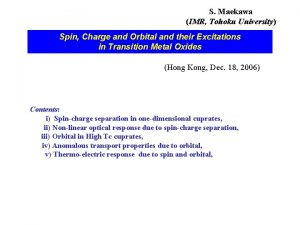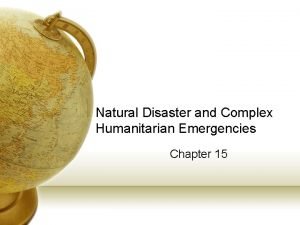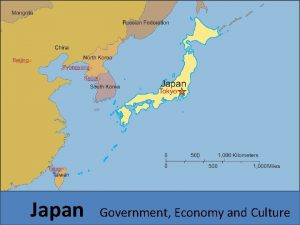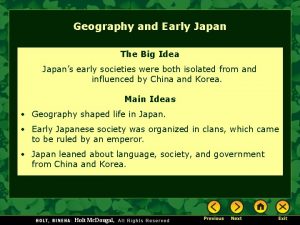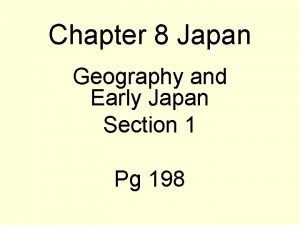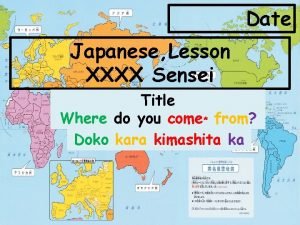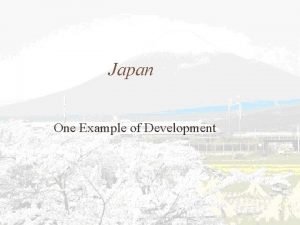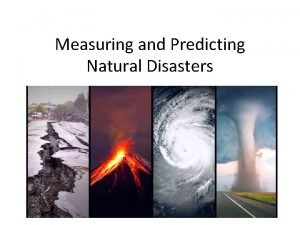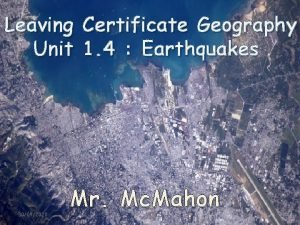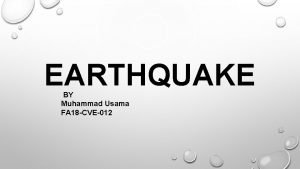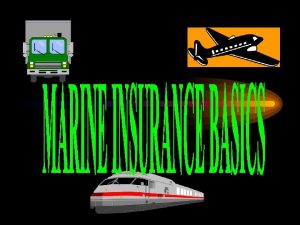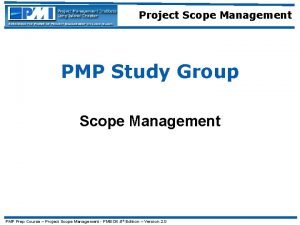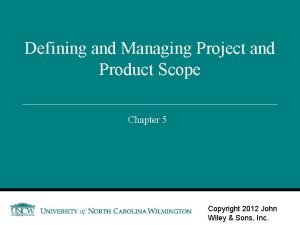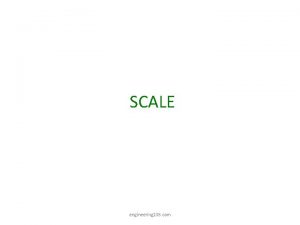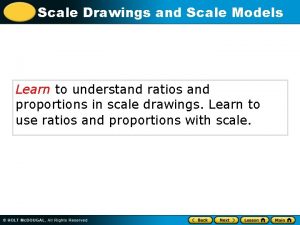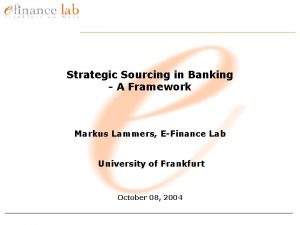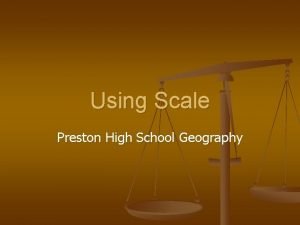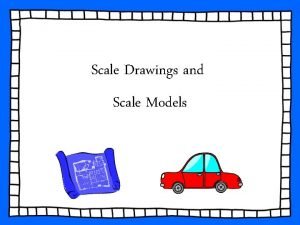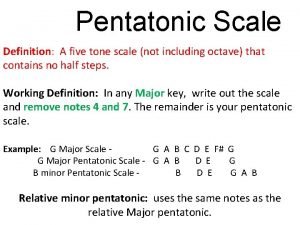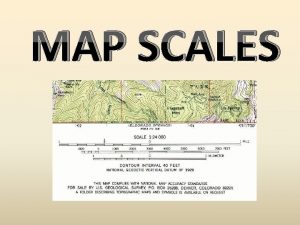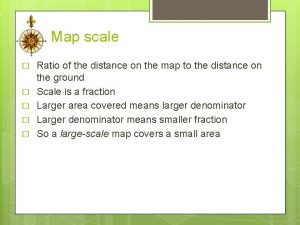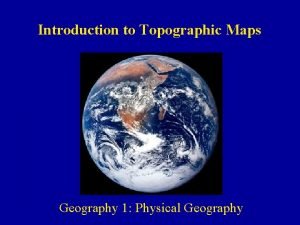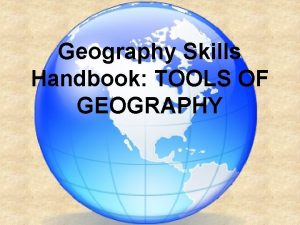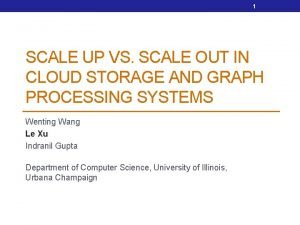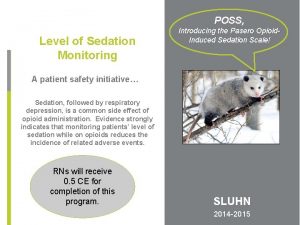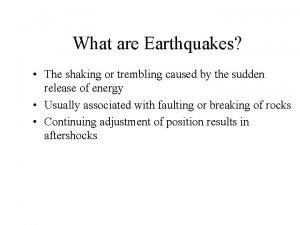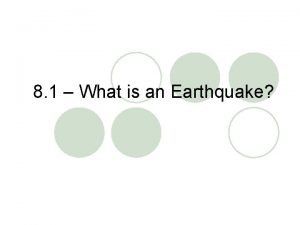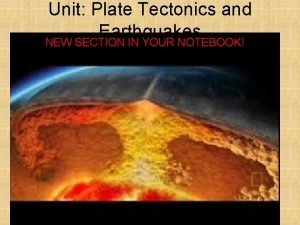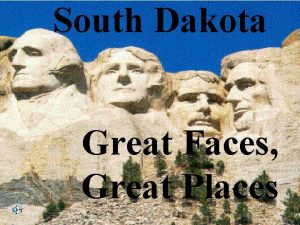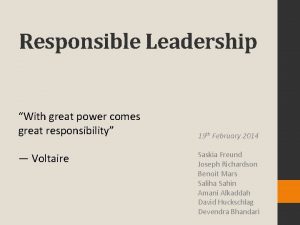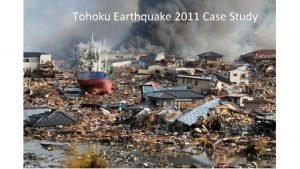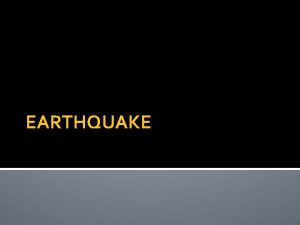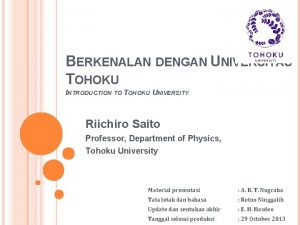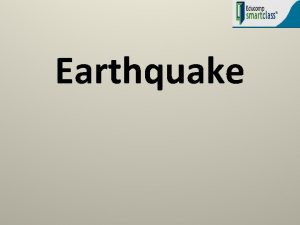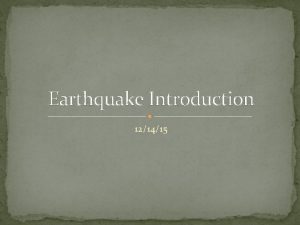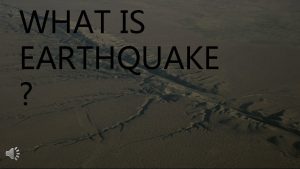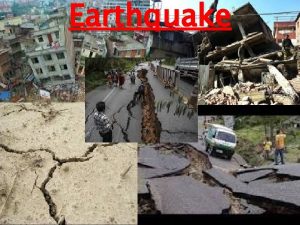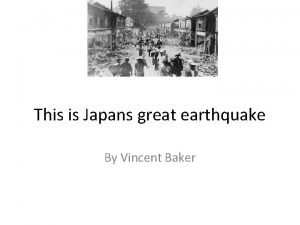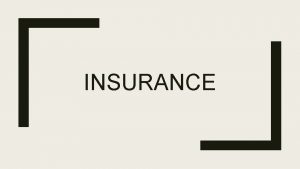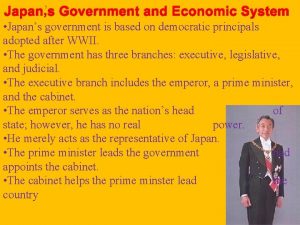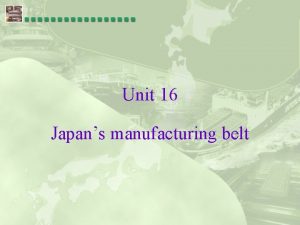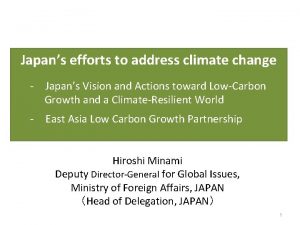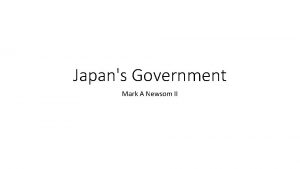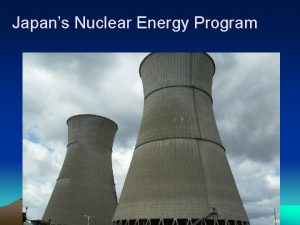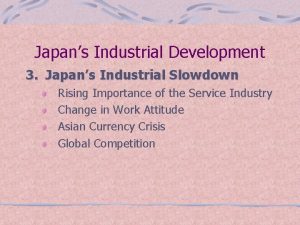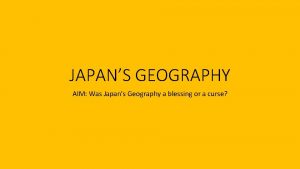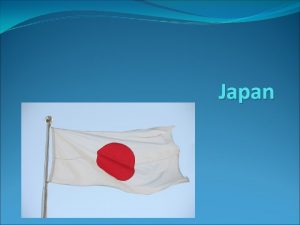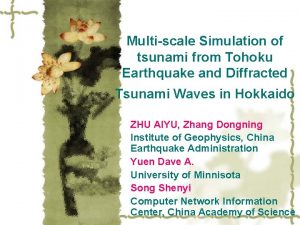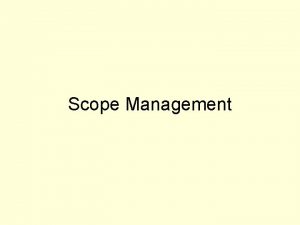Japans Great Tohoku Earthquake Scale Scope and Insurance














































- Slides: 46

Japan’s Great Tohoku Earthquake Scale, Scope and Insurance and Reinsurance Markets In the Aftermath of the March 11, 2011 Earthquake Insurance Information Institute March 15, 2011 www. iii. org/facts_statistics/earthquakes-and-tsunamis. html Robert P. Hartwig, Ph. D. , CPCU, President & Economist Insurance Information Institute 110 William Street New York, NY 10038 Tel: 212. 346. 5520 Cell: 917. 453. 1885 bobh@iii. org www. iii. org

Presentation Outline n Recent Major Global Catastrophes n Summary of March 11, 2011, Earthquake in Japan n Discussion by Peril n Historical Analysis of Japanese Earthquake Risk n Historical Analysis of Global Earthquake Risk n Historical Analysis of U. S. Earthquake Risk n 2010 Catastrophe Loss Summary and Long-Term Trends ADDITIONAL DETAILS AVAILABLE AT: http: //www. iii. org/facts_statistics/earthquakes-and-tsunamis. html 2

Summary of Recent Major Catastrophe Loss Activity Earthquake Losses Dominate 3

Recent Major Catastrophe Losses (Insured Losses, $US Billions) The March 2011 earthquake in Japan will become among the most expensive in world history in terms of insured losses (current leader is the 1994 Northridge earthquake with $22. 5 B in insured losses in 2010 dollars) Insured Losses from Recent Major Catastrophe Events Exceed $50 Billion, an Estimated $48 Billion of that from Earthquakes *Midpoint of AIR Worldwide estimated insured loss range of $15 billion to $35 billion as of March 13, 2011. Does not include tsunami losses. Sources: Insurance Council of Australia, Munich Re, AIR Worldwide; Insurance Information Institute. 4

Summary of March 11, 2011 Japanese Earthquake Activity March 11 Earthquake Is Among the Strongest in Recorded History 5

Location of March 11, 2011 Earthquake Near Sendai, Honshu, Japan March 11 Earthquake Facts as of 3/13/2009 n Magnitude 9. 0 earthquake struck Japan at 2: 46 PM local time (2: 46 AM Eastern) off the northeast cost of Honshu, 80 miles east of the city of Sendai n Quake is among the 5 strongest in recorded history and the strongest in the 140 years for which records have been kept in Japan n Thousands are dead LOCATION 130 km (80 miles) E of Sendai, Honshu, Japan 178 km (110 miles) E of Yamagata, Honshu, Japan 178 km (110 miles) ENE of Fukushima, Honshu, Japan 373 km (231 miles) NE of TOKYO, Japan Source: US Geological Service; Insurance Information Institute. n Cost will be in the billions (US $) n Significant tsunami damage was recorded in Japan, with relatively minor damage on the U. S. West Coast 6

Loss Estimates n Early estimates from the catastrophe modeling firm AIR Worldwide put insured property losses, not including the costs of the tsunami, at $15 billion to $35 billion. n AIR’s estimates reflect insured losses from shaking and “fire following” damage to onshore residential and commercial buildings and contents. n The estimates also include some agricultural losses. The figures are net of Japan Earthquake Reinsurance recoveries. n Many of the properties destroyed by the tsunami first sustained damage from ground shaking and fire. However, any other estimates of tsunami losses should not be added to the loss estimates provided here, as that would result in significant double counting. n These losses do not include uninsured property losses. According to AIR Worldwide, earthquake insurance penetration in Japan is relatively low (ranging between 14 to 17 percent nationwide). n Estimates of fatalities are still evolving, but are expected to be in the thousands. Source: AIR Worldwide, March 13, 2011. 7

Earthquake Damage n Strong shaking from the quake was felt over most of the country’s northern Honshu region. Roads across the region buckled and several landslides were reported. n High-rise office and apartment buildings in Tokyo—some 370 km from the epicenter—shook visibly. Trains and subways in the capital were halted and elevators shut down. Shaking was felt as far south as Kyoto and Osaka. n In Japan about 70% of all residential construction is made of wood and about 25% of concrete. Commercial construction consists of more than 50% ductile reinforced concrete, about one-third light metal or steel and less than 10% wood. n Residential structures in the region of Japan impacted by the March 11 quake are generally resistant to earthquake shaking. However, some vulnerable structures do exist. These are comprised primarily of non-ductile reinforced concrete frame and heavy wood-frame construction. n There have been relatively few reports of major structural damage in the Tokyo and Chiba areas, though several serious fires broke out. Many instances of nonstructural damage and damage to contents are expected to be reported. n Power outages plagued the northern Honshu region, and many homes are without running water. Source: AIR Worldwide, March 13, 2011. 8

Nuclear Concerns n An explosion in one of the buildings at the Fukushima Daiichi Nuclear Power Station prompted officials to evacuate a 12 -mile radius around the plant, affecting as many as 170, 000 people. n Officials flooded the reactor with seawater in an effort to avoid a reactor core meltdown. Reports indicated that a partial meltdown may have already occurred. n On March 13 a second reactor at the same plant was also experiencing critical failures of its cooling system. Several insurance experts have said that the plant operator, Tokyo Eclectic Power Co. , will be responsible for any clean-up costs associated with radiation contamination, but that insurance is likely to have been purchased by the company directly from the Japanese government. Source: AIR Worldwide, March 13, 2011. 9

Human Cost n The death toll, expected to rise, stands at thousands. n Deaths have been reported in Miyagi, Iwate, Fukushima and Ibate prefectures. n A ship carrying 100 people was swept away off the northeastern coast. n At least 200 people were caught in a landslide in the province of Sendai. Source: AIR Worldwide, March 13, 2011. 10

Property Damage n Building collapses, including a nursing home, reported in Fukushima prefecture; many collapses in Iwaki-city and Fukushima-city. n Building collapses reported in Ibaraki prefecture. n Three buildings collapsed in Kurihara-city in Miyagi prefecture. n Building collapses in Chiba prefecture’s Narita city. n Many residential homes washed out by the tsunami in Miyagi and Iwate prefectures. n Oil tanks were damaged in Miyagi prefecture. n More than 300 houses collapsed or were washed away in the coastal city of Ofunato. Source: AIR Worldwide, March 13, 2011. 11

Fire Damage n Fire damage in the following prefectures, particularly at chemical plants, nuclear plants and oil refineries: Iwate, Miyagi, Akita, Fukishima, Ibaraki, Tochigi, Chiba, Tokyo and Kanagawa. n Chiba prefecture: fire and explosion at an oil refinery and fire at a steel plant. n Kanagawa: fire at a mid-rise building and at an industrial facility. n Fire at one office building in Tokyo. Source: AIR Worldwide, March 13, 2011. 12

Infrastructure Damage n All highways closed around Kanto and Tōhoku. n More than four million buildings were without power in Tokyo and its suburbs. n Sendai airport was inundated by the tsunami. n Haneda airport stopped all departures. n Narita airport stopped all departures. n Ibaraki airport stopped all departures. n The Japanese railway stopped all trains in Kanto and Tōhoku; other, private, railroads stopped trains. n Cooling systems at the Fukushima Daichi power plant were damaged. Three thousand residents near the plant were being evacuated early this morning. n Electronics giant Sony Corp. and carmaker Toyota shut down production at several of their plants. Source: AIR Worldwide, March 13, 2011. 13

Discussion by Peril: Japanese Earthquake Several Different Types of Policies Must Be Considered 14

Discussion by Peril: Earthquake Shaking n This is the biggest exposure in direct sums insured. EQ Shake policies have two primary forms: high deductibles with insurance covering a proportion of the damage excess deductible; and first loss policies that have minimal deductibles but also sub-limits that are a small fraction of the fire insurance value of a property. n The ground motions in Japan were at a level that generates the expectation of widespread, moderate damage (as opposed to an expectation of the destruction seen in the Christchurch CBD, NZ). There are reports of 6, 00010, 000 houses destroyed in this event, representing a very small fraction of the housing stock affected. Most damage is expected to be below the level of deductibles. EQECAT believes this initial report of 6, 000 -10, 000 is low due to a damaged communications infrastructure that prevents timely reporting, but this bias does not significantly alter the conclusion of widespread moderate damage. n First loss policies are very likely to trigger losses to insurers in this event, especially first loss policies that apply to schedules of locations distributed throughout the area. Aggregated first loss insurance payouts are expected to be a fairly high percentage of the damage incurred by first loss policy holders. Source: Eqecat, March 14, 2011. 15

Discussion by Peril: Fire Following Earthquake n As demonstrated by many events in Japan, fire following earthquake represents a significant risk. Despite there being several very large fires from this event, there have been no uncontrolled urban conflagrations. Payouts from the EFEI (Earthquake Fire Expense Insurance) are not expected to be significant; the individual payouts are very limited on a policy basis. n Fire losses are not expected to be a large portion of the insured losses for this event; the small number and size of fires has limited the number of houses affected and the insurance limits are a small fraction of the overall fire losses. n Many fires have been identified within the rubble piles caused by the tsunami. It is not clear how these policies will be settled, but the initial cause of these rubble piles was likely the tsunami not fire. The largest fires have been within industrial facilities, primarily refineries and power production facilities. Source: Eqecat, March 14, 2011. 16

Discussion by Peril: Flood and Tsunami n Indemnification from flooding and tsunami is an optional coverage for most policies in Japan, and take-up rates are fairly low. It is currently expected that much of the losses from flooding are not insured. n The University of Tokyo (ERI) has posted a ground motion summary from the National Research Institute for Earth Science and Disaster Prevention based on data captured by networks of strong-ground-motion instruments in Japan (K-Net and Ki. K-Net data). The data includes many recordings closer to the fault where peak ground acceleration exceeded 0. 5 g (quite strong) in some cases. Therefore, the shaking damage along the coast might have been significant in some regions; however, these same regions (especially the lowlands where the strongest shaking would have been) were overrun by the tsunami, thus erasing any evidence of possible shaking damage. Source: Eqecat, March 14, 2011. 17

Discussion by Peril: Nuclear Contamination Evacuation n Most insurance policies contain exclusions for nuclear contamination. The experience from past earthquakes has been that there is not a lot of business interruption coverage that could be triggered by the large-scale evacuations now in progress. Source: Eqecat, March 14, 2011. 18

Discussion by Peril: Loss Estimates – Comparisons With Previous Major Quakes n Economic losses from this event are likely to exceed $100 B USD, according to March 14 estimates by Eqecat. The 1995 Great Hanshin Earthquake (Kobe, Japan) was reported to have economic losses in excess of this value. The Great Hanshin event was a M 6. 8 earthquake located in the heart of the port of Osaka. It occurred in a larger industrial center, and was more concentrated geographically. n Insured losses from the 1995 event were estimated at $6 Billion USD (a ratio of insured losses to economic losses of 6%). The relatively low ratio was due to the low propensity to buy earthquake insurance coverage in this area of perceived low risk. Last week’s Tohoku Pacific Offshore Earthquake affected an area that has a much higher rate of insurance purchase. A $100 Billion USD loss represents about 2% of Japan’s Gross Domestic Product. This ratio allows a comparison of the severity of this event with other recent catastrophes. Source: Eqecat, March 14, 2011. 19

Discussion by Peril: Loss Estimates – Comparisons With Previous Major Quakes (con’t) n The 2010 Maule Earthquake (Chile) caused an estimated $30 Billion USD in economic damages. With a GDP of approximately $300 Billion USD, the 2010 Maule earthquake was a far more direct hit although about 25% of the economic losses were covered by insurance. The aggregate economic losses from the two recent Christchurch, NZ, earthquakes may approach $20 Billion USD on a GDP of approximately $120 Billion USD. n Current estimates note that approximately 75% of the Christchurch losses will be covered by insurance. In 2004, Hurricane Katrina caused an estimated $125 Billion USD in economic losses to an economy with a GDP of $13 Trillion USD, or about 1%, with approximately 25% of the losses covered by insurance. n Economic losses will continue to rise as significant earthquake-related events develop; serious concerns grow as officials struggle to control damage at three nuclear power plants. Source: Eqecat, March 14, 2011. 20

Japanese Nonlife Insurance Market Facts Market Is Dominated by Large, Domestic Insurers 21

Top 20 Nonlife Insurance Companies in Japan by DPW, 2008 Direct premiums written, 2008 Rank Source: © AXCO 2011. Companies 1 Tokio & Marine Nichido 2 JPY (millions) U. S. ($ millions) Market share Cumulative Market Share $2, 032, 131. 2 $19, 660. 9 24. 0% Sompo Japan 1, 504, 262. 7 14, 553. 8 17. 8 41. 8% 3 Mitsui Sumitomo 1, 455, 161. 8 14, 078. 7 17. 2 59. 0% 4 Aioi 897, 182. 6 8, 680. 3 10. 6 69. 6% 5 Nipponkoa 728, 262. 9 7, 046. 0 8. 6 78. 2% 6 Nisay Dowa 361, 530. 7 3, 497. 8 4. 3 82. 5% 7 Fuji 329, 345. 7 3, 186. 4 3. 9 86. 4% 8 AIU 253, 522. 8 2, 452. 8 3. 0 89. 4% 9 Kyoei 199, 393. 1 1, 929. 1 2. 4 91. 8% 10 Nisshin 149, 735. 8 1, 448. 7 1. 8 93. 6% 11 American Home 82, 889. 8 802. 0 1. 0 94. 6% 12 Asahi 73, 600. 1 712. 1 0. 9 95. 5% 13 Sony 60, 868. 3 588. 9 0. 7 96. 2% 14 ACE 54, 876. 2 530. 9 0. 7 96. 9% 15 Zurich 45, 471. 3 439. 9 0. 5 97. 4% 16 SECOM 44, 245. 0 428. 1 0. 5 97. 9% 17 Sumi Sei 33, 594. 0 325. 0 0. 4 98. 3% 18 AXA 30, 418. 9 294. 3 0. 4 98. 7% 19 Mitsui Direct 29, 471. 9 285. 1 0. 4 99. 1% 20 Daido 15, 690. 4 151. 8 0. 2 99. 3% 22

Top 10 Nonlife Insurance Companies in Japan by DPW, 2008 Direct premiums written, 2008 Rank Companies JPY (millions) 1 2 3 4 5 6 7 8 9 10 Tokio & Marine Nichido Sompo Japan Mitsui Sumitomo Aioi Nipponkoa Nisay Dowa Fuji AIU Kyoei Nisshin $2, 032, 131. 2 1, 504, 262. 7 1, 455, 161. 8 897, 182. 6 728, 262. 9 361, 530. 7 329, 345. 7 253, 522. 8 199, 393. 1 149, 735. 8 Source: © AXCO 2011. U. S. ($ millions) $19, 660. 9 14, 553. 8 14, 078. 7 8, 680. 3 7, 046. 0 3, 497. 8 3, 186. 4 2, 452. 8 1, 929. 1 1, 448. 7 Market share 24. 0% 17. 8% 17. 2% 10. 6% 8. 6% 4. 3% 3. 9% 3. 0% 2. 4% 1. 8% Cumulative Market Share 24. 0% 41. 8% 59. 0% 69. 6% 78. 2% 82. 5% 86. 4% 89. 4% 91. 8% 93. 6% 23

Ownership of Residential Earthquake Insurance in Japan Year Percent (1) 2009 2008 2007 2006 2005 46. 5% 45. 0% 44. 0% 41. 7% 40. 3% (1) Percentage of homeowners with fire policies who purchased earthquake insurance. In Japan quake insurance is usually purchased on top of a fire policy. Source: Non-Life Insurance Rating Organization of Japan. 24

Historical Analysis of Japanese Earthquake Activity Japan Has a Long and Tragic History of Earthquake Loss 25

Cat. Net(TM) Earthquake Map Source: Axco Insurance Information Services. 26

Significant Earthquakes/Tsunamis in Japan: 1900 – February 2011 10 Costliest Events Ordered by Overall Losses © Munich Re, Geo Risks Research, Nat. Cat. SERVICE – As at 11 March 2011

Significant Earthquakes/Tsunamis in Japan: 1900 – February 2011 10 Costliest Events Ordered by Insured Losses © Munich Re, Geo Risks Research, Nat. Cat. SERVICE – As at 11 March 2011

Significant Earthquakes/Tsunamis in Japan: 1900 – February 2011 10 Deadliest Events © Munich Re, Geo Risks Research, Nat. Cat. SERVICE – As at 11 March 2011

Historical Analysis of Global Earthquake Activity Earthquakes Are Often Costly and Deadly; Activity in 2010 and 2011 Has Been Elevated 30

Significant Earthquakes/Tsunamis Worldwide: 1980 – February 2011 10 Costliest Events Ordered by Overall Losses © Munich Re, Geo Risks Research, Nat. Cat. SERVICE – As at 11 March 2011

Significant Earthquakes/Tsunamis Worldwide: 1980 – February 2011 10 Costliest Events Ordered by Insured Losses © Munich Re, Geo Risks Research, Nat. Cat. SERVICE – As at 11 March 2011

Significant Earthquakes/Tsunamis Worldwide: 1980 – February 2011 10 Deadliest Events © Munich Re, Geo Risks Research, Nat. Cat. SERVICE – As at 11 March 2011

Historical Analysis of U. S. Earthquake Activity Most—But Not All—Major U. S. Earthquakes Have Occurred on the West Coast 34

Estimated Insured Losses for the Top 10 Historical Earthquakes Based on Current Exposures (1) ($ Billion) Rank Date Location Magnitude Insured loss (current exposures) 1 Feb. 7, 1812 New Madrid, MO 7. 7 $100 2 Apr. 18, 1906 San Francisco, CA 7. 8 96 3 Aug. 31, 1886 Charleston, SC 7. 3 37 4 Jun. 1, 1838 San Francisco, CA 7. 4 27 5 Jan. 17, 1994 Northridge, CA 6. 7 21 6 Oct. 21, 1868 Hayward, CA 7. 0 21 7 Jan. 9, 1857 Fort Tejon, CA 7. 9 8 8 Oct. 17, 1989 Loma Prieta, CA 6. 3 6 9 Mar. 10, 1933 Long Beach, CA 6. 4 5 10 Jul. 1, 1911 Calaveras, CA 6. 4 4 (1) Modeled loss to property, contents, and business interruption and additional living expenses for residential, mobile home, commercial and auto exposures as of December 31, 2008. Losses include demand surge and fire following earthquake. Policy conditions and earthquake insurance take up rates are based on estimates by state insurance departments and client claims data. Source: AIR Worldwide Corporation. 35

Catastrophe Losses Are Trending Adversely 36

Top 12 Most Costly Disasters in U. S. History (Insured Losses, 2009, $ Billions) Hurricane Katrina remains, by far, the most expensive insurance event in U. S. and world history Measured by insured losses, the 1994 Northridge earthquake is the fourth most expensive insurance event in U. S. history Sources: PCS; Insurance Information Institute inflation adjustments. 37

Share of Losses Paid by Reinsurers for Major Catastrophic Events Reinsurance plays a very large role in claims payouts associated with major catastrophes Source: Wharton Risk Center, Disaster Insurance Project, Renaissance Re, Insurance Information Institute.

Historical Global Catastrophe Loss Summary and Trends Losses Have Been Generally Increasing on a Global Scale. Capacity Will Need to Increase if Current Disaster Trends Continue 39

Significant Natural Catastrophes: 1980 – February 2011 10 Costliest Events Ordered by Overall Losses © Munich Re, Geo Risks Research, Nat. Cat. SERVICE – As at 11 March 2011.

Significant Natural Catastrophes: 1980 – February 2011 10 Costliest Events Ordered by Insured Losses © Munich Re, Geo Risks Research, Nat. Cat. SERVICE – As at 11 March 2011.

Significant Natural Catastrophes: 1980 – February 2011 10 Deadliest Events Worldwide © Munich Re, Geo Risks Research, Nat. Cat. SERVICE – As at 11 March 2011.

Natural Catastrophes Worldwide, 1980 – 2010 (Number of events with trend) Number Increased claims paying capacity will be required on a global scale if current trends continue (as is expected) Geophysical events (Earthquake, tsunami, volcanic eruption) Source: Geo Risks Research, Nat. Cat. SERVICE. Meteorological events (Storm) Hydrological events (Flood, mass movement) © 2011 Munich Re Climatological events (Extreme temperature, drought, forest fire) 43

Natural Catastrophes, 2010 Overview and comparison with previous years Average of the last 10 the last 30 years 2000 -2009 1980 -2009 2010 2009 950 900 785 615 Overall losses (US$m) 130, 000 60, 000 110, 000 95, 000 Insured losses (US$m) 37, 000 22, 000 35, 000 23, 000 Fatalities 295, 000 11, 000 77, 000 66, 000 Number of events The number and cost of natural catastrophes on a global scale was far above average in 2010 Source: Geo Risks Research, Nat. Cat. SERVICE. 44

Natural Catastrophes, 2010 950 loss events Volcanic eruption Island, March/April Severe storms, tornadoes, floods Severe storms, floods United States, 30 April – 3 May United States, 13 -15 March Severe storms, hail United States, 12 -16 May Flash floods France, 15 June Earthquake Haiti, 12 Jan. Winter Storm Xynthia, storm surge Western Europe, 26 -28 Feb. Heat wave/ Wildfires Russia, July-Sept. Landslides, flash floods China, 7 Aug. Floods Eastern Europe, 2 -12 June Floods, flash floods, landslides China, 13 -29 June Hurricane Karl, floods Mexico, 15 -21 Sept. Insurance is a global business and claims paying ability is interconnected via reinsurance markets Natural catastrophes Selection of significant loss events (see table) Source: Geo Risks Research, Nat. Cat. SERVIC. E Earthquake China, 13 April Floods, flash floods Pakistan, July-Sept. Earthquake, tsunami Chile, 27 Feb. Geophysical events (earthquake, tsunami, volcanic activity) Meteorological events (storm) Typhoon Megi China, Philippines, Taiwan, 18 -24 Oct. Hailstorms, severe storms Australia, 22 March/6 -7 March Floods Australia, Dec. Earthquake New Zealand, 4 Sept. Hydrological events (flood, mass movement) Climatological events (extreme temperature, drought, wildfire) 45

Insurance Information Institute Online: www. iii. org Thank you for your time and your attention! Twitter: twitter. com/bob_hartwig Download at www. iii. org/presentations
 Imr tohoku
Imr tohoku Tohoku
Tohoku Tohoku srp
Tohoku srp Tohoku ac jp
Tohoku ac jp Japans educational system
Japans educational system Japans literacy rate
Japans literacy rate Japans physical geography
Japans physical geography Japanese feudal hierarchy
Japanese feudal hierarchy Nara meaning japanese
Nara meaning japanese Jyamaika
Jyamaika Japans geography
Japans geography Japan hierarchy system
Japan hierarchy system Moment magnitude scale
Moment magnitude scale Causes of earthquake in points
Causes of earthquake in points Earthquake scale chart
Earthquake scale chart Nature of fire insurance
Nature of fire insurance Scope of marine insurance
Scope of marine insurance Product scope vs project scope
Product scope vs project scope Product scope vs project scope
Product scope vs project scope Scale up and scale out in hadoop
Scale up and scale out in hadoop Diagonal scale in engineering drawing
Diagonal scale in engineering drawing Scale up and scale out in big data
Scale up and scale out in big data Proper protractor orientation
Proper protractor orientation Scale drawings and models
Scale drawings and models Principle of surveying
Principle of surveying Economies of scope vs scale
Economies of scope vs scale What is a line scale
What is a line scale What is a proportional two dimensional drawing of an object
What is a proportional two dimensional drawing of an object Pentatonic music definition
Pentatonic music definition What is map scale definition
What is map scale definition Large scale map
Large scale map Introduction to topographic maps
Introduction to topographic maps Geography skills handbook
Geography skills handbook Scale-up vs scale-out
Scale-up vs scale-out How to understand scale drawings
How to understand scale drawings Poss level
Poss level Inner and outer scale of protractor
Inner and outer scale of protractor Focus and epicenter of an earthquake
Focus and epicenter of an earthquake Quizizz
Quizizz Earthquake p-wave and s-wave travel time graph
Earthquake p-wave and s-wave travel time graph Focus and epicenter of an earthquake
Focus and epicenter of an earthquake 1958 lituya bay earthquake and megatsunami
1958 lituya bay earthquake and megatsunami Turning great strategy into great performance
Turning great strategy into great performance South dakota state animal
South dakota state animal Great leader comes great responsibility
Great leader comes great responsibility Hammerhead vs great white shark size
Hammerhead vs great white shark size Did alexander the great deserve to be called great
Did alexander the great deserve to be called great
